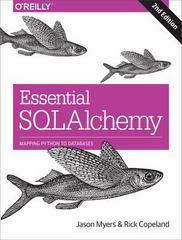Question
can you help me with these logic questions exersize 6: Let L = (V;C;R) with V = fw; yg, C = fd; eg and R
can you help me with these logic questions
exersize 6:
Let L = (V;C;R) with V = fw; yg, C = fd; eg and R = fr; sg where r has arity 1 and s has arity 2. Which of the following are atoms over L? Which are ground atoms? Justify your answers. (a) d(w;w)
(b) r(d; e)
(c) s(w;w)
(d) r(y)
Exercise 10:
Evaluate the following. (a) (p(x; y; x) ^ q(x; y; y) ^ r(y; y) ! t(x))[x=a; y=b] = ... (b) (p(x) ^ q(x) ! r(x))[x=c][x=d] = ... (c) (q(a; x) ^ p(x; y) ^ q(y; a) ! r(y))[x=a][x=b] = ... (d) (p(x; x) ^ q(x; y) ! p(x; y))[y=b][y=c][x=b] = ... Exercise 11 :Which of the substitutions in Exericse 10 are ground substitutions?
excerisize 9: where a; b are constants.
q(a),p(b),q(x) ! p(x), q(y) ^ p(y) ! r(b)
Exercise 12: Give the grounding of the Datalog program from Exercise 9.
Exercise 13: Give a Herbrand model for the Datalog program in Exercise 9.
Exercise 14: Give three distinct Herbrand models for the Datalog program P consisting of the following rules: p(a; b) q(c) p(x; y) ! q(x)
Step by Step Solution
There are 3 Steps involved in it
Step: 1

Get Instant Access to Expert-Tailored Solutions
See step-by-step solutions with expert insights and AI powered tools for academic success
Step: 2

Step: 3

Ace Your Homework with AI
Get the answers you need in no time with our AI-driven, step-by-step assistance
Get Started


